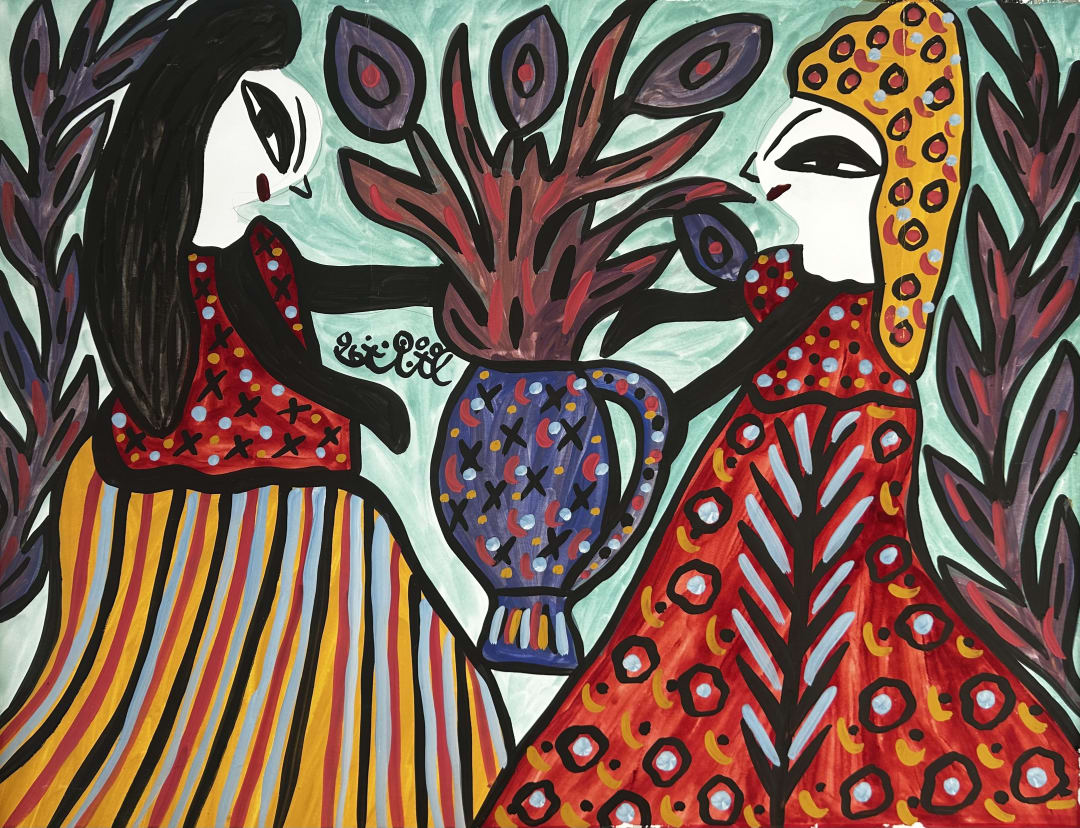“I paint what I feel. It irritates me when people ask what I’m trying to express through my painting. I give you the freedom to find in it whatever you wish (…) I paint — it’s up to you now to feel.”
Baya, 1986
BAYA née Fatma Haddad-Mahieddine
Born in Bordj - El - Kiffan, Algeria
A self-taught artist, BAYA occupies a unique place in the history of modern art. Her trajectory is dazzling, her work unclassifiable, free from any school or assignment.
Born Fatma Haddad in 1931 in Bordj El Kiffan, near Algiers, she lost her parents at a tender age. Faced with adversity, she found in art a salutary refuge and an escape that enabled her to rebuild and, above all, reveal herself. It was in this intimate space of expression that Baya was born, driven by her instinctive creativity. Her gift did not escape Marguerite Caminat, who saw in her a prodigious imagination.
In 1947, aged just sixteen, Baya exhibited at the Maeght gallery in Paris. Success was immediate. André Breton, Matisse, Braque and Derain, emblematic figures of the avant-garde, hailed her talent.
The following summer, in 1948, she explored the art of ceramics at the Madoura workshop in Vallauris, where she fashioned fantastical creatures and dreamlike animals. Her art is deeply imbued with the cultural influence of Kabyle women. Her natural mastery of gesture fascinates. Picasso, based in a nearby studio, met her on this occasion and discovered in her a promising young artist.
In 1953, on the eve of the Algerian war, Baya married Hadj El Mahfoud Mahieddine, a great master of Arabo-Andalusian music. During the years of the liberation struggle, she interrupted her artistic practice. This silence, far from being a disappearance, resounded like an act of resistance.
With Algerian independence in 1962, Baya returned to her brushes with renewed energy. Her works explode with color. They are peopled by sovereign, radiant women; liberated from the colonial yoke and patriarchal norms.
The artist invents a world of her own, where bodies dance and nature reigns supreme. Her brightly colored gouaches transform flora, fauna and everyday objects into magical motifs, revealing a deep attachment to nature, sublimated by a rare artistic mastery.
In this abundant universe, humans are absent. A choice that takes on manifesto value, for her space is governed by the feminine, free and creative.
In 1953, on the eve of the Algerian war, Baya married Hadj El Mahfoud Mahieddine, a great master of Arabo-Andalusian music. During the years of the liberation struggle, she interrupted her artistic practice. This silence, far from being a disappearance, resounded like an act of resistance.
With Algerian independence in 1962, Baya returned to her brushes with renewed energy. Her works explode with color. They are peopled by sovereign, radiant women; liberated from the colonial yoke and patriarchal norms.
The artist invents a world of her own, where bodies dance and nature reigns supreme. Her brightly colored gouaches transform flora, fauna and everyday objects into magical motifs, revealing a deep attachment to nature, sublimated by a rare artistic mastery.
In this abundant universe, humans are absent. A choice that takes on manifesto value, for her space is governed by the feminine, free and creative.
Inspired by dance and music, notably that of her husband Hadj El Mahfoud Mahieddine, Baya emancipates herself from the shackles of a conservative society to impose a joyful, sensorial and profoundly free art. Without ever claiming to belong to a particular school or artistic movement, she is part of a feminist movement. Through her gestures, she defies the hierarchies of an art world long dominated by men.
BAYA's work is a celebration of life. A rare fusion of cultural heritage and personal innovation. Today, acclaimed by the world's leading museums and exhibitions, it stands as an essential milestone in the history of modern art. Through her work, Baya has offered a vision of Algeria that is vibrant, poetic and universal, far removed from clichés and reductive views.
© AYN Gallery
